Search the Special Collections and Archives Portal
Search Results
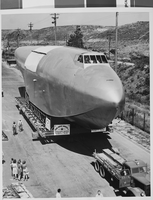
Photograph of Howard Hughes' Hercules, Culver City, California, June 16, 1946
Date
1946-06-16
Archival Collection
Description
Description given with photograph: "Fuselage of Hughes' Hercules Leaves Hangar, Culver City, Calif - Cautiously moving down the field on dollies after leaving the Culver City, Calif., plant hangar, the 200-foot hull-fuselage of Howard Hughes' Hercules is made ready for the 28-mile trip to Terminal Island, Calif., where the air giant will be assembled. NY 80 Credit Line (ACME) 6/16/46."
Image
Watercolor sketches: Central Park, New York City, New York, undated
Level of Description
File
Archival Collection
Jeanne Russell Janish Papers
To request this item in person:
Collection Number: MS-00355
Collection Name: Jeanne Russell Janish Papers
Box/Folder: Oversized Box 16
Collection Name: Jeanne Russell Janish Papers
Box/Folder: Oversized Box 16
Archival Component
Wilbur Clark at a formal dinner, New York City, New York, 1958
Level of Description
File
Archival Collection
Toni and Wilbur Clark Photographs
To request this item in person:
Collection Number: PH-00302
Collection Name: Toni and Wilbur Clark Photographs
Box/Folder: Folder 10
Collection Name: Toni and Wilbur Clark Photographs
Box/Folder: Folder 10
Archival Component
Wilbur Clark at a formal dinner, New York City, New York, 1958
Level of Description
File
Archival Collection
Toni and Wilbur Clark Photographs
To request this item in person:
Collection Number: PH-00302
Collection Name: Toni and Wilbur Clark Photographs
Box/Folder: Folder 10
Collection Name: Toni and Wilbur Clark Photographs
Box/Folder: Folder 10
Archival Component
View of New York City from New Jersey: color slide, 1943
Level of Description
Item
Archival Collection
Larry Fotine Music collection
To request this item in person:
Collection Number: MS-01179
Collection Name: Larry Fotine Music collection
Box/Folder: Digital File 00
Collection Name: Larry Fotine Music collection
Box/Folder: Digital File 00
Archival Component
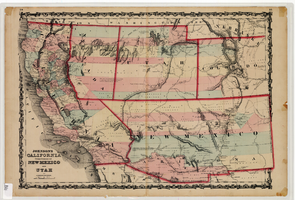
Map of California and territories of New Mexico and Utah, circa 1861
Date
1859 to 1862
Description
'Compiled, drawn, and engraved under the supervision of J.H. Colton and A.J. Johnson.' Relief shown by hachures and spot heights. Scale [ca. 1:3,041,280]. 1 in. to approx. 48 miles (W 124°--W 103°/N 42°--N 31°). Hand colored
Prime meridians: Greenwich and Washington
Plates 54 & 55 removed from Johnson's New illustrated family atlas of the world, with descriptions geographical, statistical and historical ... New York, 1862
Title page of atlas.
Prime meridians: Greenwich and Washington
Plates 54 & 55 removed from Johnson's New illustrated family atlas of the world, with descriptions geographical, statistical and historical ... New York, 1862
Title page of atlas.
Image
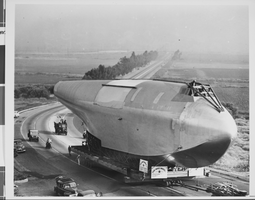
Photograph of Howard Hughes' Hercules, Culver City, California, June 16, 1946
Date
1946-06-16
Archival Collection
Description
Description given with photo: "Hull of "Hercules" Starts Journey to Assembly Dock, Culver City, Calif. - The 220-foot-long fuselage of Howard Hughes' gigantic airplane crawls down the highway on truck dollies after leaving the Culver City, Calif., plant. the hull is on its way to the graving dock for assembly at Terminal Island, Calif., 28 miles away. Note size of man on top of hull. NY EUR CAN. Credit (ACME) 6/16/46"
Image
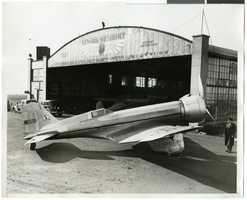
Photograph of Howard Hughes' Northrop Gamma Racer in Newark, New Jersey, January 14, 1936
Date
1936-01-04
Archival Collection
Description
A view of the side of Howard Hughes' Northrop Gamma Racer.
Image
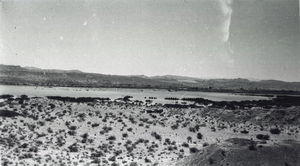
Photograph of the Lost City site and Lake Mead, near Overton, Nevada, spring 1938
Date
1938
Archival Collection
Description
Long shot of the Lost City site (Pueblo Grande de Nevada), near Overton, Nevada, with the northwest arm of Lake Mead in the distance. The area is near the ruins of St. Thomas, Nevada, another nearby extinct town, submerged by Lake Mead.
Image
New York Mine, Silver City, Nevada
Level of Description
File
Archival Collection
Mary Griffith Toleno Photograph Collection
To request this item in person:
Collection Number: PH-00021
Collection Name: Mary Griffith Toleno Photograph Collection
Box/Folder: N/A
Collection Name: Mary Griffith Toleno Photograph Collection
Box/Folder: N/A
Archival Component
Pagination
Refine my results
Content Type
Creator or Contributor
Subject
Archival Collection
Digital Project
Resource Type
Year
Material Type
Place
Language
Records Classification
